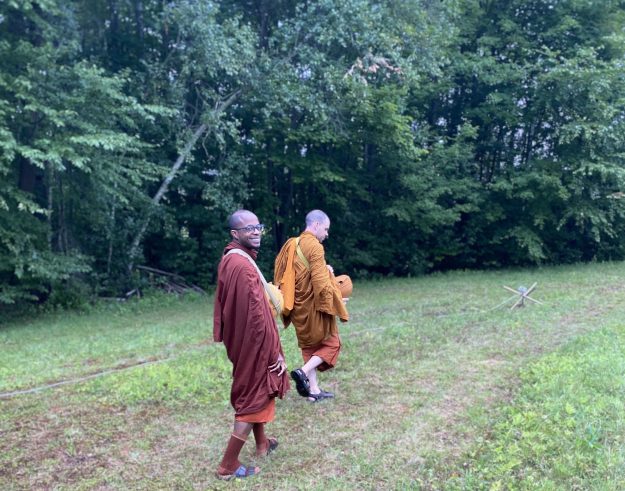Walking for Alms
A former monastic turned lay teacher recounts their earlier days wandering the streets of western Massachusetts. The post Walking for Alms appeared first on Tricycle: The Buddhist Review.

It’s the summer of 2021, and I’m spending the season in the woods of New England. There are three of us, and, in these parts, we are a strange sight. That is, a fully ordained monk, an aspirant, and I—a novice monk. In the mornings, we walk on an even stranger mission: our daily alms round. All this in a place where most folks, as open-minded as they are, have never even seen a Buddhist monk.
Walking for alms is a practice that dates back to the time of the Buddha, though it was also practiced by members of other spiritual traditions. Many of the narrative discourses in the early Buddhist texts begin with an introduction like this one:
Then the Buddha robed up in the morning and, taking his bowl and robe, entered Varanasi for alms. While the Buddha was walking for alms near the cow-hitching place at the wavy leaf fig, he saw . . . (Anguttara Nikaya 3.128)
Afterward, the main narrative, or teaching, begins, usually involving someone the Buddha encounters on his walk. In this way, alms rounds serve multiple purposes. The functional one is that monastics are fed for the day, but by walking through town, monks also make themselves visible to the public. This means people get to experience the “sight of a contemplative” (Pali: samana) that Buddhist traditions consider to be of the utmost value, an encounter the Buddha-to-be is said to have experienced before leaving home in search of enlightenment.
Of course alms round as a tradition is almost nonexistent in the United States, where the Buddhist monastic community is also notably small. In comparison to countries like Thailand and Myanmar, where monks walking with their bowls are a common sight, one would be hard-pressed to see a Buddhist monk outside of a temple in the West.
And while monasteries are trying to revive the tradition, there are several practical challenges to accomplishing this. For one, many communities live outside of walking distance to the nearest town. Additionally, in some jurisdictions, begging or solicitation is illegal, even if monastics do not technically “ask” for food. And perhaps the most difficult challenge is confronting the public’s lack of familiarity with Buddhist practices—the public at large does not usually understand the concept of alms rounds, if they have ever encountered it at all, and it can be hard for monks to obtain enough food to subsist on from just walking around town, seemingly without aim.
It’s early, and the morning air is cool but heavy with humidity. I note the metallic scent of the earth beneath our feet, a light rain shower having swept through the area shortly before sunrise. Thanks to the forest, it feels as if I’m walking along an ancient path, one the Buddha himself walked. I also note that my stomach is growling.
 Tahn Pamutto and Bradley Donaldson walk for alms. Image via Bradley Donaldson.
Tahn Pamutto and Bradley Donaldson walk for alms. Image via Bradley Donaldson.I’m not hopeful that someone will pass us on the road and offer us food—the area is quite remote, and in the hour we’ve been walking, not a single car or passerby has come our way. Our general plan, however, is to swing by the properties of supporters whom we expect to be home. When they see us, they usually offer us food—salad, fruit, nuts, sometimes food they’ve cooked themselves.
Of course there’s always the risk we may not see anyone or receive anything at all, but that has never happened to us. Not yet anyway.
At the time, I had been ordained for about a year and had recently left my home monastery in New Jersey to study and practice with a new mentor, Tahn Pamutto, who had taken up a wandering practice in western Massachusetts. Along with the aspirant Anagarika Drew, we settled in the town of Wendell, where Tahn Pamutto had formed strong connections with several of the townspeople over the years.
These connections included two very generous supporters—a married couple—who had offered us a plot of grassy land next to their home to use for summer retreat. There, we assembled tents for sleeping and renovated a small trailer, which served as our main meditation and eating space. In the shrubbery next to our tents we carved out space for a latrine. We had no electricity, but a faucet next to the trailer provided clean water.
Living like this made daily life quite uncomplicated. We awoke, arranged our robes, meditated, walked for alms, returned to eat, and then spent the day doing chores, meditating, and other logistical and personal tasks. We would reconvene in the evening for another group meditation before bed. Every now and then we would host meditation sessions in the town meeting space or borrow Wi-Fi to offer online events. Neighbors would offer their showers and laundry rooms when we needed to refresh ourselves.
What was the point of living like this? First, it was motivating to live in the open air, and it added a certain energy to our practice. Furthermore, we wanted to experience the benefits of simple living. Not for the sake of minimalism but so we could focus on certain notable qualities the Buddha had praised, namely contentment, seclusion, and having few wishes.
 Left to right: Tahn Santi, Anagarika Drew, Tahn Pamutto, and Bradley Donaldson in their meditation trailer. Image via Bradley Donaldson.
Left to right: Tahn Santi, Anagarika Drew, Tahn Pamutto, and Bradley Donaldson in their meditation trailer. Image via Bradley Donaldson.These are also the qualities that monks walking for alms are encouraged to practice, regarding the food we receive solely as nourishment:
You should train yourselves like this: ‘We will not eat too much. We will only eat after reflecting rationally on our food. We will eat not for fun, indulgence, adornment, or decoration, but only to sustain this body, to avoid harm, and to support spiritual practice. (Majjhima Nikaya 39)
As Theravada monastics trained primarily in the Thai forest tradition of Ajahn Chah, my companions and I tried to align our practice with the letter and spirit of the vinaya, the collection of Buddhist monastic rules and procedures. These texts describe, among other things, how and when monastics handle the very practical issue of getting fed.
Historically, monastic communities throughout the world have practiced as they saw fit, using the vinaya texts as a guide to varying degrees of strictness. For example, Kamala Tiyavanich notes in her book Forest Recollections that in the 20th century, monks in rural Thailand often harvested their own food because laypeople did not have the means to do their own farmwork as well as the additional farmwork for monastics.
In the northern traditions of China and Japan, over time it became more common for laypeople to offer food at the monastery and for monastics to even cook their own meals. Still, individual monks and traditions throughout space and time have tried to keep the practice of alms round alive.
Our community of three committed to only accepting food offered to us, and eating the food we received by midday. We didn’t store food, and we didn’t cook for ourselves. In general, this meant that when it came to eating, we could receive a meal primarily in three ways: from food we received on alms round, by way of a meal invitation, or when people brought food to us, usually at our campground.
I hold my bowl against my hip, mindful that my brown robe is on the verge of slipping off my shoulder. While walking on alms round, I practice metta meditation. I find this counters the fear that I won’t receive enough to eat. It also tempers greedy thoughts that pop up, like fantasies about my favorite food—sweets—or images of an overflowing bowl.
We arrive at the first home and walk slowly down the driveway toward the main building. We received permission weeks before to stop by, but as we make our way down the path, I notice inside is dark. No one is home. We wait a few moments near the main door, but no one comes out. “Onto the next one,” Tahn Pamutto says, and we turn around and head back to the main road.
It’s about thirty minutes to the next home, and I feel another hunger pang. I try to remember one of the most inspiring reflections in the Pali canon to encourage myself, a reminder about why one chooses to ordain as a monk in the first place:
I didn’t go forth from the lay life to homelessness for the sake of a robe, alms food, lodgings, or rebirth in this or that state. But I was swamped by rebirth, old age, and death; by sorrow, lamentation, pain, sadness, and distress. I was swamped by suffering, mired in suffering. And I thought, “Hopefully I can find an end to this entire mass of suffering.” (Anguttara Nikaya 3.40)
It’s true, I didn’t leave the comfort of my family home for clothing or food. In fact, those things were much easier to come by as a layperson. But I found value in living as a renunciate and dedicated myself to that path.
When we arrive at the second home, one of our supporters is in the yard tending to his pet goats. He sees us and waves us over (“Tahns!”). While he runs inside, we walk over to the fence where several goats run around, bleating under the morning sun. When he returns, he’s holding three sandwiches and a bunch of bananas. He places a sandwich in each of our bowls and separates the bunch evenly for each of us. I’m relieved.
Tahn Pamutto tells him that offering food to monastics like this is an extremely generous act that is a reflection of his goodwill. Afterward, we chant a blessing for him, a reminder in Pali that giving like this can bring only good things in the future. It’s a beautiful chant, one that to this day—even now that I have returned to lay life—still brings me peace.
We walk another hour back to camp, where we settle into the trailer to eat. I reflect on our day’s journey but also on what it took for our friend to offer us the day’s meal, in terms of effort, thoughtfulness, and material spending. This brings up gratitude, a feeling I frequently practiced as a monk. Everything I had was given to me—my robes, my bowl, the tent I slept in, the shoes I wore, and so on.
My entire spiritual life was possible due to generosity, and walking for alms almost every day, regardless of how much food we received, was a frequent reminder of that. More people than I imagined were ready to help us, even if they didn’t exactly understand what we were up to, and because of that we survived the summer in Massachusetts, and monastics everywhere continue to get by each day.
 Image via Bradley Donaldson.
Image via Bradley Donaldson.Perhaps that is what I find most beneficial about doing alms rounds in the West: It offers people a chance to exercise giving, while knowing that their very appreciated contribution is being directly used to power another’s spiritual journey. It allows folks to step outside of their daily routine, to learn why someone would give up the comforts of lay life in search of spiritual awakening. In the end, a generous person gives when they don’t have to in order to allow another human to live one more day in pursuit of spiritual fulfillment. And, in the process, they develop a more open and caring mind for themselves.

 AbJimroe
AbJimroe 































